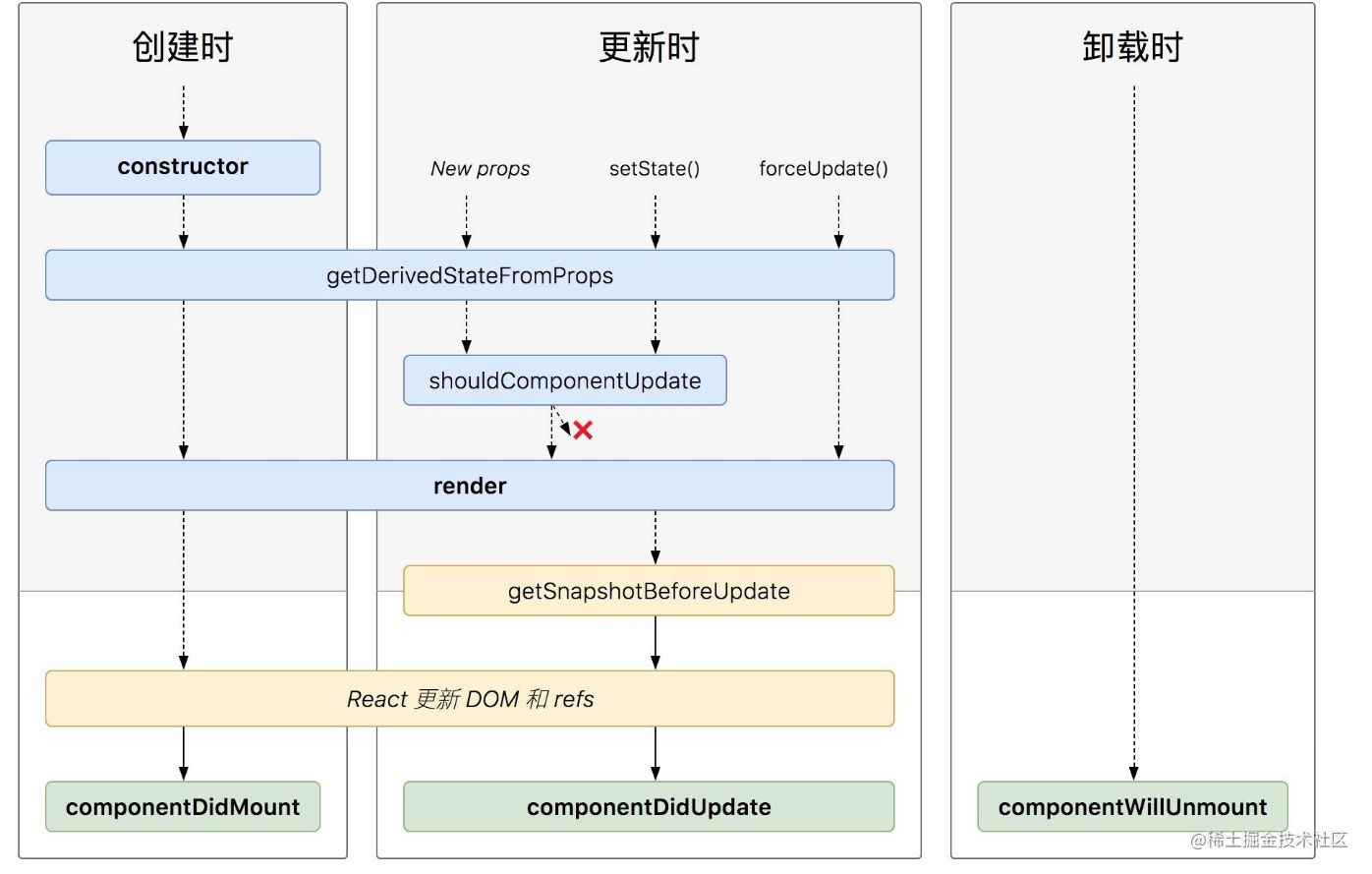React 生命周期(旧)
先来看图

React组件初始化阶段:
初始化阶段:由ReactDOM.render()触发 — 初次渲染
第一步 constructor()
用来初始化属性状态
1
2
3
4
5
6
7
| constructor(){
super()
console.log('constructor--count组件构造器');
this.state = {
count: 0,
message: '我想要吃的'
}
|
第二步 componentWillMount()
组件将要被挂载阶段 (在组件挂载之前触发)
1
2
3
| componentWillMount() {
console.log('componentWillMount--count组件将要被挂载');
}
|
第三步 - render()
组件渲染在页面上
1
2
3
4
5
6
7
8
9
10
11
12
13
14
15
16
17
18
|
render() {
console.log('render--count组件渲染');
const { count } = this.state
return (
<div className="count">
<h2>{count}</h2>
<button onClick={this.add}>+1</button>
<button onClick={this.force}>强制更新,不改变任何数据状态</button>
<br />
<div>
<h3>我是Count组件</h3>
<button onClick={this.changeMessage}>更换子组件信息</button>
<CountSon message={this.state.message} />
</div>
</div>
)
}
|
第四步 componentDidMount()
组件挂载完毕后 (在组件挂载之后,只会执行一次)
1
2
3
| componentDidMount() {
console.log('componentDidMount--count组件挂载完毕后');
}
|
这个钩子很常用,我们经常会在这个钩子中做一些初始化的操作,比如:开启定时器,发送网络请求,订阅消息等。
React组件更新阶段:
由组件内部的this.setState()或者父组件的render触发
第一步 componentWillReceiveProps()
组件将要接收参数
组件收到新的属性对象时调用,首次渲染不会触发
一般是父组件向子组件传props时,当子组件更新了props中的数据,就会触发(第一次传过去时,不会触发)
1
2
3
4
| componentWillReceiveProps(props) {
console.log('componentWillReceiveProps--Count的子组件', props);
}
|
第二步: shouldComponentUpdate()
组件是否应该被更新—-控制组件更新的“阀门”
如果为true就会按照图中所示往下走,如果为false,则将“阀门”关闭,不能往下走了。
1
2
3
4
| shouldComponentUpdate() {
console.log('shouldComponentUpdate--count组件是否应该被更新');
return true
**}**
|
第三步: componentWillUpdate()
组件将要更新
1
2
3
| componentWillUpdate() {
console.log('componentWillUpdate--count组件将要更新');
}
|
第四步:render()
会跟新新的属性对象重新渲染组件
第五步: componentDidUpdate()
组件更新完毕后触发
它接收参数(1.props更新前的,2.state更新前的,3.快照值,(在新的生命周期中会提到))
1
2
3
| componentDidUpdate(preProps, preState, snapShotValue) {
console.log('componentDidUpdate--count组件更新完毕后', preProps, preState, snapShotValue);
}
|
卸载组件阶段
由ReactDOM.unmountComponentAtNode()触发
componentWillUnmount()
组件将要被卸载时触发,
一般经常在这个钩子中做一些收尾的操作:比如:关闭定时器,取消订阅消息等。
(旧)生命周期代码测试
1
2
3
4
5
6
7
8
9
10
11
12
13
14
15
16
17
18
19
20
21
22
23
24
25
26
27
28
29
30
31
32
33
34
35
36
37
38
39
40
41
42
43
44
45
46
47
48
49
50
51
52
53
54
55
56
57
58
59
60
61
62
63
64
65
66
67
68
69
70
71
72
73
74
75
76
77
78
79
80
81
82
83
84
85
86
87
88
89
90
91
92
93
94
95
96
| import React, { Component } from 'react';
class Count extends Component {
constructor() {
super()
console.log('constructor--count组件构造器');
this.state = {
count: 0,
message: '我想要吃的'
}
}
componentWillMount() {
console.log('componentWillMount--count组件将要被挂载');
}
componentDidMount() {
console.log('componentDidMount--count组件挂载完毕后');
}
shouldComponentUpdate() {
console.log('shouldComponentUpdate--count组件是否应该被更新');
return true
}
componentWillUpdate() {
console.log('componentWillUpdate--count组件将要更新');
}
componentDidUpdate() {
console.log('componentDidUpdate--count组件更新完毕后');
}
render() {
console.log('render--count组件渲染');
const { count } = this.state
return (
<div className="count">
<h2>{count}</h2>
<button onClick={this.add}>+1</button>
<button onClick={this.force}>强制更新,不改变任何数据状态</button>
<br />
<div>
<h3>我是Count组件</h3>
<button onClick={this.changeMessage}>更换子组件信息</button>
<CountSon message={this.state.message} />
</div>
</div>
)
}
add = () => {
const { count } = this.state
this.setState({
count: count + 1
})
}
force = () => {
this.forceUpdate()
}
changeMessage = () => {
this.setState({
message: "我想要喝的"
})
}
}
class CountSon extends Component {
componentWillReceiveProps(props) {
console.log('componentWillReceiveProps--Count的子组件', props);
}
render() {
return (
<div>
<h3>我是Count的子组件</h3>
<span>我收到父组件的信息:{this.props.message}</span>
</div>
)
}
}
export default Count
|
生命周期(新)
先看图

对比 (旧)生命周期
对比俩张图发现,旧版的废弃了三个”will”,引来了俩个”get”
废弃:
- componentWillMount
- componentWillReceiveProps
- componentWillUpdate
新增:
- getDerivedStateFromProps
- getSnapshotbeforeUpdate
getDerivedStateFromProps
- 是个静态方法,需要在前面加个
static,否则会报错,如下:
Lifecycle method should be static: getDerivedStateFromProps
- 必须返回属性对象或者null,否则报错,如下:
A valid state object (or null) must be returned. You have returned undefined.
- 可以传参数
参数:新的属性对象(内部数据state),旧的状态对象(外部数据props)
官网也提出了,这个钩子不建议使用, 因为 派生状态会导致代码冗余,并使组件难以维护。在这里不过多学习它了。
getDerivedStateFromProps
在更新之前获取快照
- 有这个钩子必须也要有 componentDidUpdate 这个钩子,需要和它搭配使用
- 必须有返回值,返回值 可以是 值,也可以是
null
1
2
3
4
5
6
7
8
9
10
11
12
13
|
getSnapshotBeforeUpdate(){
console.log('getSnapshotBeforeUpdate--count')
return 'Wangpf'
}
componentDidUpdate(preProps, preState, snapShotValue){
console.log('componentDidUpdate--count组件更新完毕后', preProps, preState, snapShotValue);
}
|
getSnapshotBeforeUpdate
获取更新前的快照值,
举个例子:
1
2
3
4
5
6
7
8
9
10
11
12
13
14
15
16
17
18
19
20
21
22
23
24
25
26
27
28
29
30
31
32
33
34
35
36
37
38
39
40
41
42
43
44
| import React, { Component } from 'react';
import './News.css'
class News extends Component {
state = {
newsArr: []
}
componentDidMount() {
setInterval(() => {
const { newsArr } = this.state
const news = `新闻${newsArr.length + 1}`
this.setState({
newsArr: [news, ...newsArr]
})
}, 1000)
}
getSnapshotBeforeUpdate() {
return this.listHeight.scrollHeight
}
componentDidUpdate(preProps, preState, height) {
this.listHeight.scrollTop += this.listHeight.scrollHeight - height
}
render() {
const { newsArr } = this.state
return (
<div className="list" ref={c => this.listHeight = c}>
{newsArr.map((item, index) => {
return <div key={index} className='news'>{item}</div>
})}
</div>
)
}
}
export default News
|
上述例子描述的是 , 可以使用 该钩子来获取更新之前的 scroll 高度, 然后到它一直在滚动时,我希望它一直显示某个位置,而不是随之滚动,一直显示顶部。

总结
记住较为重要的几个钩子
- render : 初始化渲染或者更新渲染时调用的
- componentDidMount:组件挂载完毕后调用,用途如: 开启监听,发送ajax请求
- componentWillUnmount: 组件将要卸载时调用, 用途如: 做一些收尾的工作,如清理定时器,取消订阅等。
废弃的钩子
- componentWillMount
- componentWillReceiveProps
- componentWillUpdate
目前版本17.0.1,目前使用的话,会出现警告,需要加上 前缀 UNSAFE_ 才行, 但官方说了在未来18版本之后很可能彻底废弃,因此不建议使用。
